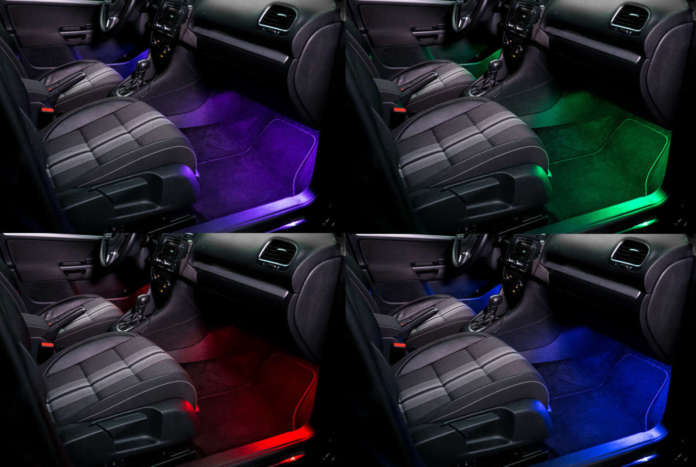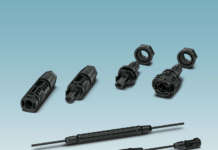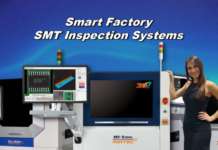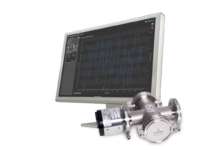In all automotive lighting systems, LEDs have been replacing existing technologies thanks to their energy efficiency, flexible design and innate impact resistance, which also makes them more durable. The small, flat design of current, high-efficiency LEDs offers plenty of scope for the design of innovative automotive products.
LEDs have contributed significantly to vehicle design, offering new styles, shapes and lighting functions. Smart lighting systems require sophisticated controls, including advanced diagnostics and control of the light beam. LEDs are available in an extremely wide range of sizes, packages and colours, according to requirements; they are made up of the following basic components:
- LED chips;
- substrate with anode (+) and cathode (-) connection;
- gold wire bonding with anode connection;
- plastic lens.
When electric current flows through the LED from the anode to the cathode, it generates light; when voltage is applied to the LED, resistance falls to zero. LEDs are very sensitive components, and if the current goes even slightly above the level permitted, they can be destroyed. LEDs should therefore never be connected directly to a source of voltage. They can be connected only if there is a current limiter or series connected resistor in the circuit. High-power LEDs are controlled by an electronic ballast supplying a constant current.
High-power LEDs use metallic heatsinks for better heat dissipation; the more easily heat is dissipated, the greater the current that can flow through the diode, generating a light emission covering a wide area. Maximum current limits must not be exceeded, however, otherwise the component will deteriorate. The thermal resistance of high-power LEDs is ten times lower than a traditional LED, while maintaining an efficiency of around 40-100 lumens.
SMD and COB LEDs
There are numerous versions of SMD LEDs, with variable sizes, shapes of package and light flow intensity. In the automotive industry they are mainly used for turn signals, brake lights and headlamps, but also to illuminate the passenger compartment.
High-power LEDs can reach currents of 1000 mA in appropriate operating conditions; they are often used on metal-core PCBs, because they require more thermal management than low-power LEDs. The most advanced LEDs are those made with Chip On Board technology, so called because they are directly connected to the circuit. The chips are soldered onto the PCB with a gold surface finish, and contact with the opposite pole is achieved by gold or aluminum wire bond. Since COB LEDs do not use reflectors, the angle of the light beam emitted is very wide. The main advantages of COB technology are its high-intensity and homogeneous illumination, making it a good choice in numerous areas of application.
LEDs in the automotive sector
The LED market for automotive lights and headlamps is constantly growing, because LEDs offer high functionality combined with excellent light output, require low energy consumption and therefore provide cost savings.
Initially, due to their high cost, LEDs were used only in the medium-high end segment of the automotive industry. However, they soon became standard throughout the industry. In addition to economic reasons, there are various technical arguments in favour of their use in standard production.
LEDs offer great functionality, technical performance and optimal lighting results. They are also energy-saving and provide greater safety in traffic. In addition, their similarity to natural light allows for a pleasant and comfortable driving experience.
For best results, the colour of the LED should be the same as the material used for the brake lights or turn signal lights.
In this way, the red and amber signals will appear brighter than when white LED bulbs are used, even when they have a lower luminous flux.
It is a question of physics: a red lens will filter all the light from a light source except the red component. So, if the light emitted by the bulb is all red, none or very little light will be blocked. Conversely, the light from a white LED bulb contains very little light belonging to the red region of the visible spectrum, so most of the light contributing to its lumen value would be filtered out. This makes the white bulb appear weaker than the red bulb.
HELLA technology
There are several methods of directing light in a particular direction. In automotive lighting these are reflection, refraction and a combination of the two.
Hella’s AFS (Advanced Frontlighting System) allows the lighting functions to be adjusted to suit different driving situations, as individual LEDs can be added or deactivated.
In order to meet various driving needs, LED technology has made the structure of a headlight more complex than in the past, and the number of components of a headlight has increased significantly. As LEDs require only a small current, a fraction (a few mA) of the current allowed is enough to make them light up with an often adequate amount of light.
The number of vehicles on the road is constantly increasing everywhere. Higher traffic density increases the risk of rear-end collisions. To avoid them, the driver must be able to perceive the light signals of the vehicle in front rapidly.
While a conventional incandescent bulb takes up to 0.2 seconds to light up, an LED reacts instantly, does not need a warm-up phase and comes on promptly, as soon as it receives the brake pedal command. The vehicle behind can thus react more quickly to the braking action of the vehicle in front.
All the functions of a taillight work on one level only, regardless of whether it is day, night or a clear or foggy morning. The only option available for adaptation in the event of adverse weather conditions is the rear fog lamp, which is often used inappropriately, causing only annoyance. Important information, such as weak or hard braking, is not transmitted.
With Hella’s adaptive signalling system, ASIGNIS, the light from the individual signals of the rear light (brake, turn signals, etc.) can be adapted to the driving conditions. The light intensity of the signal, weak during the day, brighter at night or for the braking signal, can be varied according to weather conditions and visibility.
Diverse brake signals can be more easily distinguished by enlarging the surface area of the signal, by increasing brightness or by setting a higher flashing frequency. HELLA activates the brake light in three stages, according to the level of deceleration: the stronger the deceleration, the brighter the LEDs become. If the driver brakes hard, part of the red brake light flashes, offering an additional warning signal.
The demand for optimal illumination of roadways has been challenging vehicle manufacturers for several years. On one hand, the road and the surrounding area must be perfectly illuminated to allow the driver to safely recognize people, animals and objects in the direction of travel; on the other hand, it is necessary to avoid dazzling other road users. The normal solution to this is to switch from high beam tolow beam and vice versa, as required. Neither, however, provides the best solution for ensuring safety during evening or night driving. A simple way to enhance safety in bad weather conditions could be to use the fog lights. An optimal solution is to integrate these different functions into the main headlamp and switch from one different light intensity to another automatically.
This is the basic concept of AFS headlamps. This system uses the vehicle’s steering angle and speed as parameters for adjusting the road lighting. Based on this internal information, a cylinder in the VarioX module is used to create various ways of distributing LED light, including lights for the city, for suburban roads, for the motorway and in bad weather conditions. The special feature of the VarioX module cylinder is that one side has a particular structure, while the other rotates on its longitudinal axis. A stepping motor allows the cylinder to be rotated to the required position in a few milliseconds.
CAN Bus bulbs
CAN Bus LED bulbs, produced by the American company Super Bright LEDs, are simple plug-and-play LED bulbs made specifically for vehicles equipped with CAN Bus. These bulbs work with the vehicle’s advanced computer system, so they respond to commands from the on-board computer.
CAN Bus stands for Controller Area Network Bus. The system monitors the vehicle and reports the status of the various operating conditions. CAN Bus systems are commonly found in European vehicles such as BMW, Audi, Mercedes, Volkswagen, Porsche and many other American vehicles. Each vehicle has different requirements that the CAN Bus system can ascertain. In most cases, however, the status of the CAN Bus LED bulbs in areas such as the rear of the vehicle, brake and running lights are constantly monitored. This function is not possible with standard LED bulbs, which would constantly give a “light off” signal.
CAN Bus LED bulbs should not be used in non-CAN Bus applications, as, in most cases, they can cause problems in other circuits of the vehicle. A CAN Bus LED bulb has greater resistance than original bulbs, due to their built-in resistors, and can cause feedback in other circuits of non-CAN Bus electrical systems.
LED lighting uses much less energy and lasts much longer than regular incandescent bulbs. The low current absorption of the LEDs diminishes the load on the battery and generator. However, replacing traditional turn signal bulbs with LEDs will cause something known as hyperflashing. Hyperflashing is when the turn signals flash rapidly, and it occurs because, as new LED bulbs absorb very little energy, the system perceives the bulb as being burned out. With little or no modification, however, the LED Flasher module, designed to work with both LED and incandescent bulbs at the same time, can be installed. Not all vehicles can be equipped with LED bulbs, however.
Overview of LED Osram bulbs
One of the first applications of LED lighting was the architecture of interiors and exteriors, due to the special types of atmosphere this light can create; with LEDs it is also possible to create different types of atmosphere inside a vehicle, adding a personalized look in an innovative way.
LEDambient CONNECT, by Osram, is designed to highlight details inside vehicles with bright colours, while the free LEDambient CONNECT app allows the user to synchronize colour sequences with musical rhythm, using Bluetooth technology.
Whether it’s the interior of a camper, car or truck, 90 LEDs provide 12W of intense light with a colour temperature of 4500K. LEDambient interior strips are self-adhesive, can be shortened and are easy to install, without screws or welding.





